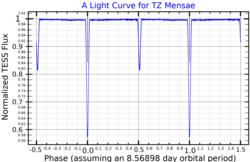Astronomy:TZ Mensae
TZ Mensae is a binary star in the southern circumpolar constellation Mensa. The system has a combined maximum apparent magnitude of 6.19,[12] placing it near the limit for naked eye visibility. Parallax measurements place the system at a distance of 403 light years.[2] The radial velocity is small.[7]
The components of TZ Mensae have stellar classifications of A0 V and A8 V,[6] both indicating that they are ordinary A-type main-sequence stars. They have masses of 1.5 and 2.5 M☉, and radii of 1.4 and 1.9 R☉, respectively.[10] The primary has an effective temperature of 10,543 K and a luminosity 40 times that of the Sun (L☉).[10] As for the companion, it has a temperature of 7,178 K. and a luminosity less than five L☉[10] The rotation of both stars is apparently synchronous with the orbital period, with projected rotational velocities of 12 and 16 km/s respectively.[9] The system is estimated to be 141 million years old.[6]
The two components take about 8 days to revolve around each other in a relatively circular orbit.[9] Since the inclination is close to 90° (actually 88.7°),[9] the two stars periodically pass in front of one another and it has been classified as a eclipsing binary, specifically the Algol type.[5] If the brighter component is eclipsing the dimmer one, the brightness drops to 6.36.[5] If vice versa, it drops to 6.87,[3] which is below the limit for naked eye visibility.
References
- ↑ "MAST: Barbara A. Mikulski Archive for Space Telescopes". Space Telescope Science Institute. https://mast.stsci.edu/portal/Mashup/Clients/Mast/Portal.html.
- ↑ 2.0 2.1 2.2 2.3 2.4 Brown, A. G. A. (2021). "Gaia Early Data Release 3: Summary of the contents and survey properties". Astronomy & Astrophysics 649: A1. doi:10.1051/0004-6361/202039657. Bibcode: 2021A&A...649A...1G. Gaia EDR3 record for this source at VizieR.
- ↑ 3.0 3.1 Watson, C. L.; Henden, A. A.; Price, A. (May 2006). "The International Variable Star Index (VSX)". Society for Astronomical Sciences Annual Symposium 25: 47. Bibcode: 2006SASS...25...47W.
- ↑ 4.0 4.1 Johnson, H. L.; Mitchell, R. I.; Iriarte, B.; Wisniewski, W. Z. (1966). "UBVRIJKL Photometry of the Bright Stars". Communications of the Lunar and Planetary Laboratory 4: 99–110. Bibcode: 1966CoLPL...4...99J.
- ↑ 5.0 5.1 5.2 Samus’, N. N.; Kazarovets, E. V.; Durlevich, O. V.; Kireeva, N. N.; Pastukhova, E. N. (January 2017). "General catalogue of variable stars: Version GCVS 5.1". Astronomy Reports 61 (1): 80–88. doi:10.1134/S1063772917010085. ISSN 1063-7729. Bibcode: 2017ARep...61...80S.
- ↑ 6.0 6.1 6.2 6.3 6.4 6.5 Kovaleva, D. A. (December 2001). "Age and metallicity estimates for moderate-mass stars in eclipsing binaries". Astronomy Reports 45 (12): 972–983. doi:10.1134/1.1426128. ISSN 1063-7729. Bibcode: 2001ARep...45..972K.
- ↑ 7.0 7.1 Gontcharov, G. A. (November 2006). "Pulkovo Compilation of Radial Velocities for 35 495 Hipparcos stars in a common system". Astronomy Letters 32 (11): 759–771. doi:10.1134/S1063773706110065. ISSN 1063-7737. Bibcode: 2006AstL...32..759G.
- ↑ Anderson, E.; Francis, Ch. (2012). "XHIP: An extended hipparcos compilation". Astronomy Letters 38 (5): 331. doi:10.1134/S1063773712050015. Bibcode: 2012AstL...38..331A.
- ↑ 9.0 9.1 9.2 9.3 9.4 9.5 9.6 9.7 Andersen, J.; Clausen, J. V.; Nordstrom, B. (March 1987). "Absolute dimensions of eclipsing binaries. XII. TZ Mensae.". Astronomy and Astrophysics 175: 60–70. ISSN 0004-6361. Bibcode: 1987A&A...175...60A.
- ↑ 10.0 10.1 10.2 10.3 Malkov, O. Yu. (January 1993). "Catalogue of astrophysical parameters of binary systems". Bulletin d'Information du Centre de Donnees Stellaires 42: 27. ISSN 1169-8837. Bibcode: 1993BICDS..42...27M.
- ↑ "TZ Men". SIMBAD. Centre de données astronomiques de Strasbourg. http://simbad.u-strasbg.fr/simbad/sim-basic?Ident=TZ+Men.
- ↑ Høg, E.; Fabricius, C.; Makarov, V. V.; Urban, S.; Corbin, T.; Wycoff, G.; Bastian, U.; Schwekendiek, P. et al. (March 2000). "The Tycho-2 catalogue of the 2.5 million brightest stars". Astronomy and Astrophysics 355: L27–L30. ISSN 0004-6361. Bibcode: 2000A&A...355L..27H.
<ref> tag with name "Gould1879" defined in <references> is not used in prior text.
 |


